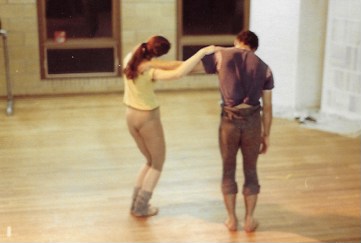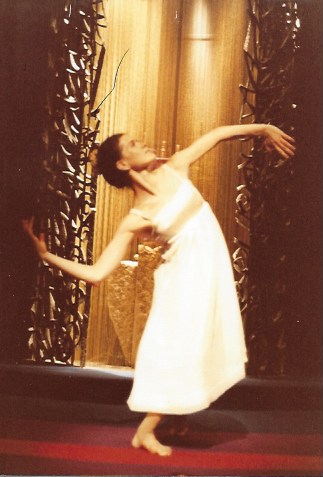In the last post I mentioned the piece I Never Saw Another Butterfly. It was actually created in 1977 in Tallahassee, Florida receiving its first New York performance at Temple Israel in 1978. This was the first of four pieces that I created between 1977 and 2002 to remember the Holocaust or as memorial pieces for the Holocaust. The book I Never Saw Another Butterfly first came out in the early 60’s. By 1977 there was a lot of interest in the poems both in music and in dance. In fact, I was not the only choreographer that year to set some of the poems. Pearl Lang created her I Never Saw Another Butterfly in 1977, as did Wendy Osserman collaborating with composer Peter Schlosser.
Pearl Lang was a member of the Martha Graham Dance Company from 1942 to 1952. When she left the company to form her own company in 1952, one of the first pieces she did was Song of Deborah, and she continued to often create works related to her Jewish background. In a radio interview in 1977 she referred to the piece I Never Saw Another Butterfly as a memorial to the Holocaust. I did not get to see Lang’s Butterfly but I did see an earlier piece she created in 1960 called Shirah, which I found hauntingly beautiful. I also had the opportunity to study with Pearl in 1960 at the Connecticut College Summer Dance Program. For six weeks in an hour-long composition class a small group of students, maybe four or five of us, worked on studies. I was assigned to do a laughter study and an anger study. Another older member of the class created a piece inspired by the fragile character Laura in The Glass Menagerie by Tennessee Williams. I don’t remember the dancer’s name but the delicate way she wove movement together left a lasting impression.
In dance classes with Louis Horst at Juilliard, particularly his second year class called Modern Forms, he often encouraged us to visit museums and to even develop pieces inspired by the art that we saw. The Museum of Modern Art was one of my favorite places to go and there was one picture that I was strongly drawn to. Titled Hide and Seek, it was painted by Pavel Tchelitchew in 1942. The picture is a tree made up of children. There are arms reaching for each other, faces calling out, hands and toes as roots of the tree. Standing in front of the painting I felt life and death captured in the same moment. The painting seemed to cry out to me just as the poems in I Never Saw Another Butterfly did. In studying the painting I saw five particular parts that stood out and so I decided to limit the piece and only set five of the poems. Each dancer would recite a poem as they moved based on the five images that stood out.
In my file on I Never Saw Another Butterfly is a postcard of the painting, sent to me by Nanette Joslyn, a dancer in the NY Company in the early 80’s who also shared that she was dancing at the time with Pearl Lang in a spoof on the Esther–Modecai story.

A description of the book tells us that 15,000 children under the age of 15 passed through the concentration camp of Terezin. Fewer than 100 survived. The poems and also pictures that they drew shared both the daily misery as well as their hopes and fears, their courage and optimism.
There are only a few pieces of my choreography that I could get up and do now or at least set with only limited help of a video, and I Never Saw Another Butterfly is one of them. I also think it had the longest history of performances in the company, being performed through the early 2000’s. It opens with the group of dancers close together doing a random number of steps and stops as if they were bundled in a train car that stopped and started in no particular pattern. 1 hold 2 walk 3, 4, 5, hold 6 walk 7 and so the piece starts. Later they peel off and take shapes related to the poem and it is from these shapes that each dancer emerges to begin his or her poem.

I was still performing with the company and my poem began:
I'ld like to go away
Where there are other nicer people,
Somewhere in the far unknown
Where no one kills one another.
After the first performance in Tallahassee, a member of the audience that I only knew casually came up to me and said he was very moved by the piece and that he was about to close out a bank account and wanted Avodah to have the balance left of $600. That was a large contribution for our little company back in 1977 and we were most grateful.
The title poem captures both the optimism and the despair:
The last, the very last
So richly, brightly, dazzling yellow
Perhaps if the sun's tears would sing
Against a white stone.
Such, such a yellow
Is carried lightly way up high.
It went away I'm sure
Because it wished to kiss the world goodbye.
For seven weeks I've lived in here,
Penned up inside this ghetto
But I have found my people here
The dandelions call to me
And the white chestnut candles in the court
Only I never saw another butterfly.
As I write this, I have a sinking feeling in my stomach, aware of the current news where we in this country are separating immigrant children from their parents and putting them in large detention camps behind barbed wire and bars. Maybe this piece needs to be revived and seen again with the backdrop of current day pictures reminding us that we cannot be silent and allow this to continue.
[print_link]
Links to Recent Blogs
[catlist name=name of category]






